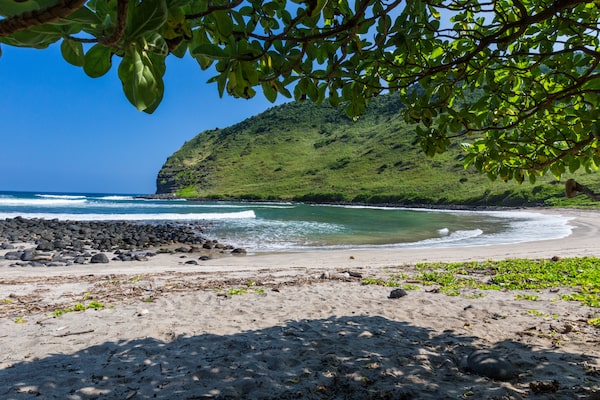
A beach in Halawa Valley, on the Hawaiian island of Moloka'i.Hawaii Tourism Authority
Arriving at the Moloka’i Airport after a 30-minute flight from Honolulu, it’s hard to believe that I’m still in the same state as its urban capital. Looking around the small open-air arrivals room as I wait for my suitcase, there’s no conveyor belt for incoming luggage (it’s loaded carefully onto a bench), no tour buses idling at the curb and certainly no Starbucks. What there is, however, is what people travel thousands of kilometres for in the first place: a real vacation, one that’s free from distraction in a quiet, palm tree-filled paradise.
The state of Hawaii may be far from the hustle and bustle of daily life, but Moloka’i is where you go to really escape. The island has one hotel, the Hotel Moloka’i, a collection of Polynesian-style bungalows where guests lounge in hammocks by the pool or on their private patios. Cell service is spotty and yes, there’s WiFi, but who needs the internet when you can watch crabs dance on the beach at sunrise?
Moloka’i is alternately referred to as the “friendly island” and the “most Hawaiian island,” and it’s clear that the locals take great pride in both. The fifth largest island of Hawaii, Moloka’i has a population of about 8,000 residents, and everyone seems to know everyone. Here, the common greeting includes a hug and a kiss on the cheek.

The plumeria is used to make Hawaii's famous leis.Hawaii Tourism Authority
From the airport, I set out on a rainy drive across the southern coast of the island towards Halawa on the northeastern side of the island. My first stop is Molokai Plumerias, a farm that since 1982 has been growing the fragrant flowers used in Hawaii’s famous leis. Owner Dick Wheeler guides me on how to pick the best flowers and make my own yellow lei. The farm also ships the buds to buyers on the mainland. He tells me that he often hears from Hawaiians living away from the islands, telling him they cry when they open their boxes of flowers. The distinct scent is of the plumeria is that powerful, like the morning dew in a tropical paradise, and it reminds them of home. “It’s more than just a flower – it’s remembering,” he says.
Farther down the road in the town of Kaunakakai, the largest on the island, there are a handful of restaurants and shops, including Kanemitsu Bakery, a famous spot for hot bread. Sold only after dark out of a window in a back alley, these warm round loaves are cut in half and slathered with toppings such as strawberry, cream cheese and cinnamon; get the works for US$10.50. On Saturdays, Kaunakakai hosts an outdoor Moloka’i Farmers’ Market, where vendors sell everything from sarongs, crafts and jewellery made of local seashells to food such as tropical fruit and Philippine adobo.
Continuing down Highway 450, I come to Saint Joseph Church. The small white chapel, dating back to 1876, is one of four built by Saint Damien, a Roman Catholic priest from Belgium famed for coming to Moloka’i to serve leprosy patients who had been exiled to the island’s Kalaupapa peninsula. Travellers can access the peninsula, located across the island on its north side, by mule or can view it from atop a local lookout.

The Halawa Valley Falls Cultural Hike takes visitors to the Mo'oula Falls.Hawaii Tourism Authority
The landscape only gets more lush and wild as I continue east. Rocky shores give way to occasional beaches and vacation rental properties, small beachfront homes, condos and cabins perfect for families. I arrive at the starting point for a hike to Mo’oula Falls, near Halawa Beach Park. Because it’s raining, the Halawa Valley Falls Cultural Hike out to the falls has been cancelled, but guides Greg Kawaimaka Solatorio and his father, Anakala Pilipo Solatorio, give me a crash course in Hawaiian history and the rich culture that was suppressed for decades after the United States overthrew the Kingdom of Hawaii in the 1890s. The language, traditions and knowledge were passed down in secret for decades.
Greg explains the significance of the kukui nut in the lei that I’m wearing. It’s considered sacred for its use as medicine, food and as a candle, and wearing it, as people often do in leis, is meant to serve as a reminder to live with honour and light. “A lot of people come to the islands to see our culture but never really get the culture. Everybody gets the show,” he says. “My thing with my visitors is actually helping them to really see Hawaii.” And Moloka’i is about as real as it gets.
The writer was a guest of the Hawaii Tourism Authority. It did not review or approve this article.